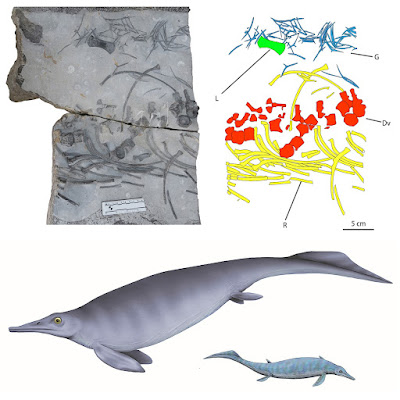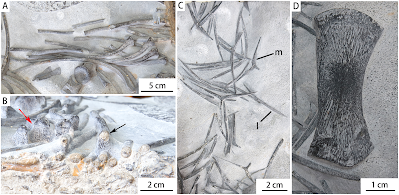 |
| Baisesaurus robustus Ren, Jiang, Xiang, Sullivan, He, Cheng & Han, 2022 DOI: 10.7717/peerj.13209 |
Abstract
Here we describe a newly discovered basal ichthyosauromorph from the Lower Triassic of South China, Baisesaurus robustus gen. et sp. nov. The only known specimen of this new species was collected from the Lower Triassic (Olenekian) Luolou Formation in the Zhebao region of Baise City, on the northwest margin of the Nanpanjiang Basin, and comprises a partial skeleton including the ribs, the gastralia, a limb element, 12 centra, and seven neural arches. Comparisons to a wide variety of Early Triassic marine reptiles show Baisesaurus robustus to be a basal ichthyosauromorph based on the following features: neural arches lack transverse processes; dorsal ribs are slender, and not pachyostotic even proximally; and median gastral elements have long, sharp anterior processes. The limb element is long and robust, and is most likely to be a radius. Baisesaurus robustus is large (estimated length more than 3 m) relative to early ichthyosauromorphs previously discovered in China, and shares noteworthy morphological similarities with Utatsusaurus hataii, particularly with regard to body size and the morphology of the probable radius. Baisesaurus robustus also represents the first record of an Early Triassic ichthyosauromorph from Guangxi Autonomous Region, extending the known geographic distribution of ichthyosauromorphs in South China.
Systematic Paleontology
Reptilia Linnaeus, 1758
Diapsida Osborn, 1903
Ichthyosauromorpha Motani et al. 2015
Baisesaurus gen. nov.
Etymology. “Baise” indicates the provenance of the only known specimen of the genus, which was discovered in Zhebao Township in Baise City; -saurus is a common suffix for genus names of fossil reptiles.
Baisesaurus robustus sp. nov.
Etymology. The Latin word robustus means “robust”.
Holotype. CUGW VH107, a partial associated postcranial skeleton.
Locality and horizon. Northwest margin of the Nanpanjiang Basin, Zhebao Township, Longlin County, Baise City, Guangxi, China; upper part of the Luolou Formation, Lower Triassic (upper Spathian).
Diagnosis. A large basal ichthyosauromorph with a unique combination of postcranial characters (* denotes an autapomorphy): anterior dorsal centra deeply amphicoelous, with an average height to length ratio of about 1.2; neural spine long and inclined posteriorly, with the postzygapophyses much more dorsally positioned than the prezygapophyses; parapophyses subrectangular with their anteroventral corners extended to form ventrally directed apices, and situated adjacent to the anterior margins of the centra; diapophyses well developed and semicircular in outline; deep fossae present posterior to the diapophyses*; and radius robust, elongate, and bearing two distal facets, the posterior facet being 80% as wide as the anterior one*.
Conclusions:
Baisesaurus represents a newly reported large basal ichthyosauromorph from the Lower Triassic of South China. Among previously described taxa, Baisesaurus is most similar to Utatsusaurus, and differs from other, smaller Chinese early ichthyosauromorphs. Baisesaurus is the first Early Triassic ichthyosauromorph to be reported from Guangxi. Together with Cartorhynchus (Motani et al., 2015a), Sclerocormus (Jiang et al., 2016) and two recently discovered species of Chaohusaurus (Chen et al., 2013; Huang et al., 2019), Baisesaurus expands the known geographical distribution of early ichthyosauromorphs in China. Alongside other recent finds, Baisesaurus implies a need for further studies of the paleoecology and paleogeography of Early Triassic ichthyosauromorphs in order to understand their role in the ecosystem at the eastern margin of the Paleo-Tethys. The discovery of Baisesaurus has considerable paleogeographic significance, as well as adding to the documented taxonomic diversity of South China’s ichthyosaur fauna in the Spathian interval of the Early Triassic.
Jicheng Ren, Haishui Jiang, Kunpeng Xiang, Corwin Sullivan, Yongzhong He, Long Cheng and Fenglu Han. 2022. A New Basal Ichthyosauromorph from the Lower Triassic (Olenekian) of Zhebao, Guangxi Autonomous Region, South China. PeerJ. 10:e13209. DOI: 10.7717/peerj.13209


